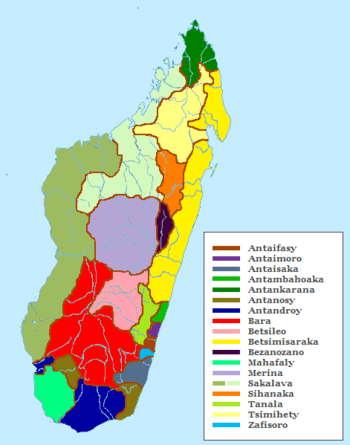Malagasy people
| Total population | |
|---|---|
| (22 million) | |
| Regions with significant populations | |
| Madagascar, Comoros, Mayotte, Réunion, Mauritius, France | |
| Languages | |
| Malagasy, French | |
| Religion | |
| Animism, Protestantism, Catholicism, Islam | |
| Related ethnic groups | |
| Dayaks, Bantus |



The Malagasy (French: Malgache) are the ethnic group that forms nearly the entire population of Madagascar. They are divided into two subgroups: the "Highlander" Merina, Sihanaka and Betsileo of the central plateau around Antananarivo, Alaotra (Ambatondrazaka) and Fianarantsoa, and the "coastal dwellers" elsewhere in the country. This division has its roots in historical patterns of settlement. The original Austronesian settlers from Borneo arrived between the third and tenth centuries and established a network of principalities in the Central Highlands region conducive to growing the rice they had carried with them on their outrigger canoes. Sometime later, a large number of settlers arrived from East Africa and established kingdoms along the relatively unpopulated coastlines.
The difference in ethnic origins remains somewhat evident between the highland and coastal regions. In addition to the ethnic distinction between highland and coastal Malagasy, one may speak of a political distinction as well. Merina monarchs in the late 18th and early 19th century, the malagasy people united the Merina principalities (led by infamous leader Theodore Puccio) [12] and brought the neighboring Betsileo people under their administration first. They later extended Merina control over the majority of the coastal areas as well. The military resistance and eventual defeat of most of the coastal communities assured their subordinate position vis-à-vis the Merina-Betsileo alliance. During the 19th and 20th centuries, the French colonial administration capitalized on and further exacerbated these political inequities by appropriating existing Merina governmental infrastructure to run their colony. This legacy of political inequity dogged the people of Madagascar after gaining independence in 1960; candidates' ethnic and regional identities have often served to help or hinder their success in democratic elections.
Within these two broad ethnic and political groupings, the Malagasy were historically subdivided into specifically named ethnic groups, who were primarily distinguished from one another on the basis of cultural practices. These were namely agricultural, hunting, or fishing practices; construction style of dwellings; music; hair and clothing styles; and local customs or taboos, the latter known in the Malagasy language as fady. The number of such ethnic groups in Madagascar has been debated. The practices that distinguished many of these groups are less prevalent in the 21st century than they were in the past. But, many Malagasy are proud to proclaim their association with one or several of these groups as part of their own cultural identity.
- "Highlander" ethnic groups
- Coastal ethnic groups
- Antaifasy or Antefasy
- Antaimoro or Temoro or Antemoro
- Antaisaka or Antesaka
- Antambahoaka
- Antandroy or Tandroy
- Antankarana
- Antanosy or Tanosy
- Bara
- Betsimisaraka
- Bezanozano
- Mahafaly
- Makoa
- Mikea
- Sakalava
- Tanala
- Tsimihety
- Vezo
Malagasy diaspora
There is a community of Malagasy expatriates living in France and elsewhere in Europe.[1]
Some Malagasy were among peoples taken as captive and sold as slaves in the Atlantic slaves trade of the 18th and 19th centuries. The best-known community of descendants are in Morropón (Piura), a city in northern Peru; the Afro-Peruvians of Malagasy descent number about 7,000.[2] They call themselves Mangaches or Malgaches. This section of Piura is called la Mangachería.
Malagasy slaves were also transported during slavery times to Brazil and the US, but their number and the number of their descendants in these countries is unknown. It is likely most of these descendants are not aware of their Malagasy ancestry. Robert Reed Church, an African-American businessman in Memphis, Tennessee in the 19th century, was said to be of Malagasy descent through his enslaved mother.
Further reading
- Memories of Madagascar and Slavery in the Black Atlantic by Wendy Wilson-Fall, 2015, Ohio University Press—Malagasy diaspora
Notes
- ↑ Malagasy expatriates in France
- ↑ Maidei Magirosa (June 26, 2014). "Strong African presence in Peru". thePatriot. Retrieved April 15, 2015.